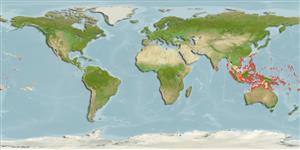Preferred temperature (Ref.
123201): 26.5 - 29, mean 28 °C (based on 294 cells).
Phylogenetic diversity index (Ref.
82804): PD
50 = 0.5000 [Uniqueness, from 0.5 = low to 2.0 = high].
Bayesian length-weight: a=0.01023 (0.00477 - 0.02194), b=3.02 (2.84 - 3.20), in cm total length, based on LWR estimates for this (Sub)family-body shape (Ref.
93245).
ความสามารถในการกลับคืนสู่ปกติ (Ref.
120179): ความสูง, เวลาต่ำสุดที่จะทำให้ประชากรเพิ่มขึ้นเป็น 2 เท่าใช้เวลาน้อยกว่า 15 เดือน (Preliminary K or Fecundity.).
Fishing Vulnerability (Ref.
59153): Low vulnerability (10 of 100).
Nutrients (Ref.
124155): Calcium = 264 [125, 651] mg/100g; Iron = 1.29 [0.62, 2.52] mg/100g; Protein = 18.2 [16.2, 19.9] %; Omega3 = 0.173 [0.069, 0.376] g/100g; Selenium = 25.6 [10.8, 57.8] μg/100g; VitaminA = 143 [37, 527] μg/100g; Zinc = 3.18 [1.94, 4.93] mg/100g (wet weight);
